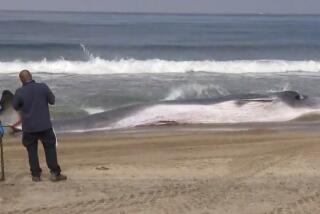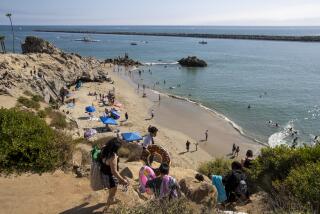Up and Down the Coast, It Was Dolphin Census Day
At first glance, Jerry Velasquez and Ruby Martinez, wearing swimsuits and reclining in beach chairs, looked right at home Saturday among the sunscreen-basted bodies scattered around lifeguard tower 19 at Huntington State Beach.
But something here was different. Equipped with a telescope, binoculars and a clipboard, the pair were watching for bottlenose dolphins, hoping to catch a glimpse of the playful mammals that frequent the shallow coastal waters of Southern California.
The pair were part of the most ambitious undertaking ever to count the number of near-shore bottlenose dolphins along a 232-mile stretch of coast from the Mexican border to Point Conception. About 200 volunteers stood on bluffs, piers, jetties and lifeguard towers simultaneously for two hours Saturday in an effort to help estimate the dolphin population.
The dolphin census was the brainchild of Orange County marine biologist Dennis Kelly, who contends that the first step in protecting the species is determining how many inhabit local waters. The mass observation Saturday was the third but biggest Kelly has organized in the past year, and by dayâs end it appeared it was the most successful.
Spotters, spaced about a mile apart along most of the Orange County and San Diego coast, reported seeing more than 130 dolphins in about 14 groups, or pods. Two
research boats and a light plane were also used to help verify the onshore sightings.
âWe are very excited,â said Kelly, who has studied dolphins for a decade as a professor at Orange Coast College in Costa Mesa and formed the nonprofit Coastal Dolphin Survey a year ago. âWe had more people involved and more dolphins spotted than the previous attempts. The news is very encouraging.â
Kelly has scheduled one final mass dolphin watch Oct. 8, and then plans to present his findings to the American Cetacean Society in November.
Scientists estimate that about 550 to 600 of the slate gray bottlenose dolphins live off the Southern California coast.
In recent years, Kelly and his research partner, Richard Defran of the San Diego-based Cetacean Behavior Laboratory, have identified about 350 dolphins by photographing their dorsal fins. The scientists study the markings, nicks and scars on the dorsal fins to tell the animals apart.
Identifying the dolphins, Kelly said, is a key to understanding and protecting the fragile habitat which is under increasing threat from pollution, heavy commercial fishing and boat traffic. Without knowing the dolphinsâ population, he said it will be hard to tell whether the species is thriving or dying.
Pinpointing the dolphin population may also unlock answers about the speciesâ migration and feeding habits and may shed more light on the theory that bottlenose dolphins are year-round residents in local waters, not seasonal visitors.
Critics complain, however, that the mass sightings are nothing more than an exercise in logistics, and that Kelly is simply trying to attract attention for his Marine Mammal Research Group at Orange Coast College. He acknowledges that his reliance on untrained volunteers to accurately identify bottlenose dolphins 200 yards offshore is not foolproof.
âBut whatâs the alternative?â Kelly said. âNobody even studied the bottlenose dolphins until the mid 1970s, and now Iâm worried the species is in trouble. At least weâre trying to do something positive.â
The dolphins along the Southern California coast are the same species as those that washed onto beaches from New Jersey to Virginia last summer. About 800 dolphins washed ashore, and scientists estimate another 5,000 of the animals were killed. A common ocean bacteria has been blamed for their deaths, but scientists still do not know why the microorganism killed so many, and why the animal became susceptible to it, said Brian Gorman, a spokesman for the National Oceanic and Atmospheric Administration.
âOne thing that has become clear, the effect of the deaths on the bottlenose population on the East Coast is more profound than we had feared last year,â Gorman said. âWe now feel that between 20% and 50% of the species may have died.â
Thatâs why Genny Anderson, a marine biologist at Santa Barbara City College and coordinator of the sighting effort in Santa Barbara, says Kellyâs effort is so vital.
âThis may shed some light on how bottlenose dolphins are surviving environmental jolts,â Anderson said.
So far along the Southern California coast, there have been no reports of dolphin deaths similar to those on the Eastern Seaboard.
But scientists are concerned that local bottlenose dolphins would be the first to feel the negative effects of manâs presence because of their proximity to the shore. The common dolphin, which number in the several thousand, and the Pacific whiteside dolphin, which rarely are seen, are also native to Southern California waters, but live well offshore.
In Orange County on Saturday, about 70 dolphins were spotted by some of the 105 volunteers positioned along the coast.
Kelly, however, was not so lucky. The biologist spent nearly seven hours aboard Orange Coast Collegeâs research vessel, a 55-foot trawler named Marta, and never saw a single dorsal fin. As the boat, about a mile offshore, slowly worked its way south from Seal Beach with no luck, a frustrated Kelly quipped: âThis is the part they never show you on those Jacques Cousteau specials.â
Ingri Quon, a San Diego student, shared Kellyâs frustration. From her post on the Pacific Beach Pier in San Diego County, she counted âkayakers, lots of boats and three jet skiersâ but no dolphins. Although a bit disappointed, the 17-year-old, who wants to become a marine biologist, seemed resigned to her results. âIâm going to be doing a lot of this,â she said.
In Santa Barbara on Saturday, Sherry Piatt, who owns the Blue Dolphin Cafe, watched for dolphins from her beachfront eatery. If nothing else, she said, âthis project is going to bring attention to the plight of the dolphin and any attention is needed. They are the most valuable mammal left on this earth and theyâre dwindling away.â
In Los Angeles County, 40 volunteers manned 17 posts from White Point north to Zuma Beach. But they managed to sight only one pod of dolphins, far off Point Vicente on the Palos Verdes Peninsula.
âThey arenât commonly in Santa Monica Bay,â said Pat Petersen, an administrative assistant with the Oceanic Society, a private, Santa Monica-based group. âPerhaps the pollution in the bay keeps them out.â
In Huntington Beach, the scientific exercise ended on an up note for Velasquez and Martinez.
They were nearing the end of their watch, preparing to pack it in, when Velasquez shouted: âThereâs one now!â
Martinez grabbed her binoculars and confirmed the sighting just beyond the surf line. Two more arrived, then a group of three. Several broke off from the main group and put on a show for the spotters, playing tag in the surf, then swimming in circles off the bow of a passing sailboat.
After waiting nearly two hours, the pair had been rewarded.
âThis is great!â Martinez exclaimed. âThis made the wait worth it.â
Staff writers Rick Vanderknyff in Orange County, Joe Menn in San Diego, Paul Feldman in Los Angeles and Steven Elzer in Santa Barbara contributed to this story.
More to Read
Sign up for Essential California
The most important California stories and recommendations in your inbox every morning.
You may occasionally receive promotional content from the Los Angeles Times.










